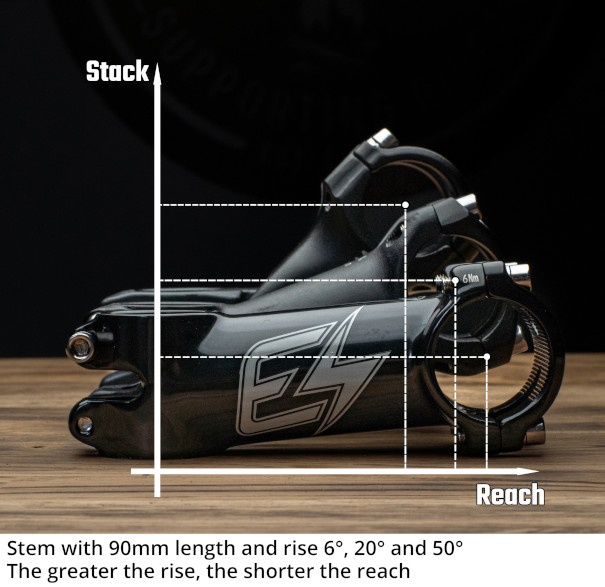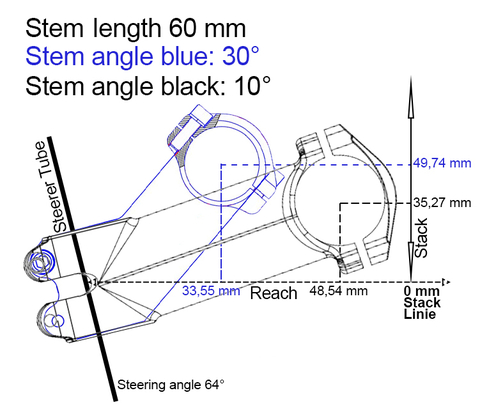Stem Calculator
Determining the Reach & Stack of a Stem
Do you have problems getting the optimum cockpit setup – or are you looking to try something different to see the benefit? With our stem calculator we give you a guide on what you can change with the stem values.
What are the differences between a short and a long stem?
The longer the stem, the more the body moves towards the handlebars, which creates more pressure on the front wheel but also a more indirect steering feel.
A long stem is ideal for riders who prefer long tours or riders who have problems with the front wheel lifting on steep climbs (this can also be remedied by a forward riding position). Longer stems are also interesting for tall people who sit too upright on their bike. Stems longer than 50 mm are mostly used in the All Mountain / Touring or XC and Marathon Race sector.
The shorter the stem, the more upright you sit on your bike. The pressure on the wheels tends to move more in the direction of the rear wheel. In combination with a low stem, you achieve an upright riding position, which nevertheless develops enough grip on the front wheel due to the low stem.
This type of setup is ideal for downhill-oriented riders who prefer a direct steering feel. In Gravity and Enduro, stem lengths between 35-50 mm are usually used.
What is the difference between a stem with a high or low stem angle? 
The higher the stem angle, the shorter the bike feels, which means you sit more upright on the bike.
This takes pressure off the front wheel and gives you a more direct steering feel, but the bike tends to understeer more.
The lower the stem angle, the longer the bike looks, which makes you sit more sporty and stretched out on the bike.
The bike feels longer and you get more pressure on the front wheel. In return, the steering feel is more indirect.
It usually becomes problematic if you only want to change one value.
This is because stem length and stem angle are related. For this reason we have developed a calculator for you, with which you can display the reach and the stack of your stem. This way you can find out which stem you would have to buy if you only wanted to change one parameter.
For a better understanding we have given you an example below.
Let's say you have a stem with a length of 60 mm and an angle of 30°. This means that the reach of your stem is 33.55 mm and the stack is 49.74 mm. You now want to lower your stack by 15 mm. If you were to buy a 60 mm stem with a 10° angle, your stack would reach the desired value (from 49.74 to 35.27 mm), but your reach would increase (33.55 to 48.54 mm).
This change in length would give you a much more stretched riding position. However, if you want to keep your reach and only lower the stack, you would have to buy a stem with a length of 50 mm and an angle of 20° (reach: 34.73 mm, stack 35.97 mm). It will rarely be possible to get exactly the same values, as most stems are only available in standardised sizes. Therefore, slight tolerances (like here with the reach 33.55 mm to 34.74) cannot be avoided.
Steering angle:
Stem length:
Stem angle:
Reach in mm:
Stack in mm:




